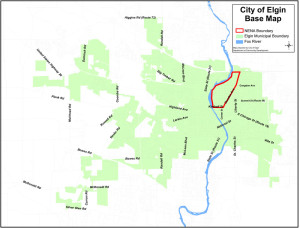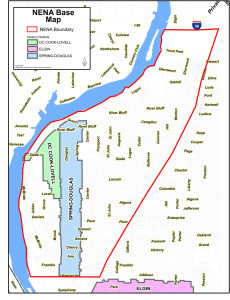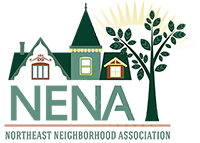Our Neighborhood

The Northeast Neighborhood of Elgin is between Kimball to the south and I-90 to the north, and the Fox River on the west to Dundee Avenue on the east. (Map credit: Department of Community Development, City of Elgin)
The northeast neighborhood has several assets that set it apart from other neighborhoods in Elgin. Within the NENA boundaries, historic homes abound. In 2000, the Spring/Douglas Historic district was named on the National Registry of Historic Places.
The Spring/Douglas Historic District is located in the north section of Elgin on the east side of the Fox River. The district encompasses both sides of Spring Street and Douglas Avenue for a distance of twelve blocks. These two streets run parallel to each other northward from the downtown area. The district terminates north of River Bluff Road.
In addition to the rich history of the neighborhood, we have two historic districts, easy access to the bike path and downtown Elgin, and thousands of wonderful neighbors. Learn more about our neighborhood on this page.
-
The History of Our NeighborhoodLike much of the city, this historic district developed during Elgin’s boom years of the late 19th century. Much of this land was platted and subdivided in the 1840s and 1850s and the earliest remaining dwellings in the district date to just before the Civil War. The growth of the city’s dairy industry and the establishment of the Elgin National Watch Company resulted in a dramatic increase in Elgin’s population towards the end of the century. Housing construction moved northward from the downtown area and by 1890 an electric streetcar line ran up Douglas Avenue. Dozens of homes were built on these two streets which reflected the popular national architectural trends of the period including the Queen Anne and related styles.
Douglas Avenue was called “Elgin’s Fashionable Avenue” by a local newspaper in 1884 and it was home to many of the city’s leading citizens. Numerous large dwellings were also built on Spring Street and this section of the city was one of the preferred residential areas of the turn of the century. In addition to the residential construction, the Sherman Hospital was built just east of Spring Street during the 1890s. This hospital complex greatly expanded in the next century and today is an important institutional landmark adjacent to the district.
The district continued to develop in the early 20th century and many fine Colonial Revival and Prairie style dwellings were built in the years just before and after World War I. Both streets were largely developed by 1930 and only a few buildings were constructed after this period. The Spring/Douglas Historic District continues to contain some of Elgin’s finest historic architecture and it remains an attractive residential section of the city.
-
Historic Districts in Our Neighborhood
 No other neighborhood in Elgin can claim two historic districts within its boundaries. In the Northeast Neighborhood, we have the Spring/Douglas Historic District and the DC Cook/Lovell Area Historic District.
No other neighborhood in Elgin can claim two historic districts within its boundaries. In the Northeast Neighborhood, we have the Spring/Douglas Historic District and the DC Cook/Lovell Area Historic District.
The Spring/Douglas Historic District received designation in 1996 as Elgin’s 2nd local historic district and in 2000 as a National Register District. Predominantly mid-19th Century through 1920s houses comprise the buildings in this historic district. Architectural styles are represented by a variety of victorian, including Queen Anne and Neo-Gothic, and of early-20th Century, including Georgian Revival and Prairie-Style.
The DC Cook/Lovell Area Historic District received designation in 2007 as Elgin’s 4th local historic district, which is characterized by turn-of-the-20th Century through 1930s houses with examples also from the 1940s and 1950s. Most architectural styles are associated with the early-20th Century, including Colonial Revival, Craftsman Bungalow, Tudor Revival, and American Foursquare. A few examples represent the late-19th Century, including Queen Anne and Italianate.
-
Nature in Our NeighborhoodThe Northeast neighborhood sits in a lucky juxtaposition of two mighty forces: metropolitan and environmental. Thus, a crisp February morning may find you cross-country skiing parallel to a pair of bald eagles as they cruise the Fox for breakfast; that evening, after savoring a delicious ethnic dinner, you head over to The Hemmens to be regaled by Beethoven’s “Choral Fantasy” courtesy of Illinois’ Orchestra of the Year (2005), the Elgin Symphony Orchestra. The summer brings early morning jogs or bike rides, where one may spy a pair of fawns, immobile at the forest edge, see a junior fox looking out-of-place and a bit confused to be caught in daylight or hear the plaintive tweets of a trio of fledgling swallows still begging for food. That afternoon, the thrill of the perfect vintage “find” encourages more hunting at Elgin’s antique and vintage shops. The exclamation point at the end of your day: rocking out to Joan Jett at Elgin’s Festival Park. All these urban and nature experiences fall within a one-mile radius of the Northeast neighborhood!
As much as we love our metropolitan amenities, the natural environment of our neighborhood keeps us sane. The Northeast neighborhood’s considerable natural resources include: the Fox River; Trout Park; hundreds of mature trees; and several parks, including the NENA Butterfly Garden.
- The Fox River: The Northeast neighborhood is bounded to the west by the Fox River, a 130-mile remnant of the retreat of Pleistocene glaciers. It is considered Kane County’s most precious natural resource. The Fox River Basin includes many varied ecosystems home to an impressive array of wildlife. Lucky bi-pedals such as ourselves have easy access to these natural environs via: the Fox Valley Bike Trail; Trout Park and many more parks that stretch along the river; canoe or kayak as a bi-paddle from a neighborhood boat launch; and dedicated shoreline, e.g. at Slade Ave. Park, where anglers cast for a muskie, catfish and bass. As the health and cleanliness of the Fox River continue to improve, so do the variety and health of surrounding wildlife. Some locally-viewed wildlife supported by the Fox and its basin include: overwintering American Bald Eagles, herons, egrets, kingfishers, cormorants, indigo buntings, ducks, geese, muskrats, beavers, (and the anticipated return of the river otter), turtles, frogs, toads, muskies, catfish, and bass. Visit and use the river as often as possible; share your appreciation of the river with friends, family, politicians, and policymakers! Join Friends of the Fox River www.preservethefox.org and help lead clean-up and protection efforts, or start a NENA group that celebrates this incredible resource.
- The Fox River Trail: The Fox River Regional Bike Trail stretches 39.75 miles from Algonquin to Aurora, passing through various Kane County Forest Preserves, including: Fox River Shores, Tyler Creek, Voyager’s Landing, Tekakwitha Woods, Fabyan Forest Preserve, Les Arends || Glenwood Park, and Durant Peterson House || Pioneer Sholes School. Within our neighborhood’s boundaries, the trail passes through Elgin’s Trout Park; and Slade Avenue Park (a boat launch and a nice stretch along the river to cast for fish).
- Trout Park: Trout Park crowns our neighborhood’s northern border with the jewels of its unique fen environment. Rare species such as the white cedar coexist with surreal skunk cabbage and delicate bloodroot. Daily spring walks through this preserve challenge one to notice its subtle changes competing for your attention from the riotous arrivals–queue the bright yellow blooms of the marsh marigold. It is a designated Illinois Nature Preserve which garners it the highest of protections. The trail through the fen portion (high-quality spring and seep areas remnant from our glacial ages) crosses little bridges, goes uphill and down in quarter-mile loop that can be accessed from Trout Park Boulevard near the ball field or at the northeast corner of Trout Park Boulevard’s and Duncan Avenue. Parking is available but please don’t bring your dogs to this part of the park. Dogs are welcome (leashed, of course) at the riverside (west of Duncan Ave) portion of the park which touts: a short little nature trail with educational signage about river ecosystems; fishing opportunities; paths along the river; a gazebo; parking; and a single, over-utilized outhouse. The eastern portion of the park skirts Route 25 and boasts a ball field with night lights, a large playground, a picnic shelter (which can be rented), and, hopefully, additional outhouses.
- NENA Butterfly Garden: Introducing the lepidoptera family: butterflies and moths. These flying beauties are among the pickiest eaters on our planet. The monarch butterfly will lay her eggs only on the plant species Asclepias spp, aka, milkweed plants. Luckily, these finicky friends will find a well-stocked “nursery” at the NENA Butterfly Garden: a healthy patch of common milkweed, Asclepias syriaca, as well as Asclepias tuberosa (pretty, orange-flowered butterfly weed). The monarch caterpillars feed only on Asclepias as they fatten from 3mm to more than 10 cm in size. The fragrant blooms of Asclepias provide nectar to adult monarchs as well as many other species of butterflies. Other lucky larvae can feast on parsley, dill, and broccoli at a patch dedicated just for them. Providing larval plants for our local lepidoptera is a key component in a butterfly garden. Additionally, offering nectar sources for the entire season is crucial. At the NENA garden, suitable nectar-producing flowers are blooming from the end of May through the beginning of October; these have been supplemented with butterfly-preferred annuals (zinnias, salvia, alyssum, e.g.). Providing native, non-hybridized plant species helps support the lepidoptera’s success. You can help, too, by planting milkweed for monarchs, dill for swallowtails, zinnias for all. Visit the butterfly garden to get ideas for your own garden! The Butterfly Garden is located at the corner of Ann Street and Douglas Avenue. It was made possible by the City of Elgin’s donation of the land, funding from a Neighborhood Improvement Grant, the dedication of NENA’s butterfly committee, and the hard work of scores of volunteers who dug, planted, weeded, and watered the garden (and continue to do so). Special recognition is due to McKinley Elementary students who have helped at the garden from its start. Each year, they have planted hundreds of butterfly-friendly annuals; they have raised almost 100 monarchs to release in the garden over the years. Future plans include adding educational components to the garden. This summer, sixteen neighborhood kids met for three weeks at the garden as junior lepidopterists. Each student created a scientific drawing of a butterfly native to our area and researched its habitat requirements. These drawings land permanently in the Garden this fall thanks to another Neighborhood Improvement Grant.
- More Nature & Mature Trees: Arching oaks, massive maples, and towering spruce impress with their beauty and shelter with their enormity. NENA residents of all kinds benefit from the shelter and beauty of our mature trees. These trees host numerous bird species, including: woodpeckers, nuthatches, Baltimore orioles, cardinals, blue jays, indigo buntings, eastern pee wees, and Cooper’s hawks, to name a few. Squirrels, raccoons, and possums also enjoy the shelter of the big trees (not to mention our homes’ big attics!). Other NENA wildlife sightings include foxes, coyotes, deer, skunks, chipmunks, muskrats, turtles, snakes, frogs, and hummingbirds.
If you’d like to make a general donation to NENA, you can do so by clicking the link below. We thank you in advance!
